ASTEROIDS
8-3 Most asteroids orbit the Sun between Mars and Jupiter
In 1802, less than two years after the asteroid Ceres (now also a dwarf planet) was discovered, the German astronomer Heinrich Olbers observed another faint, starlike object that moved against the background stars. He called it Pallas, after the Greek goddess of wisdom. Like Ceres, Pallas orbits the Sun in a nearly circular path between the orbits of Mars and Jupiter. Pallas is even dimmer and smaller than Ceres and has a diameter of only 600 km (375 mi).
239
Only two more of these asteroids— AU, between the orbits of Mars and Jupiter. This region of the solar system is now called the asteroid belt (Figure 8-
AU, between the orbits of Mars and Jupiter. This region of the solar system is now called the asteroid belt (Figure 8-
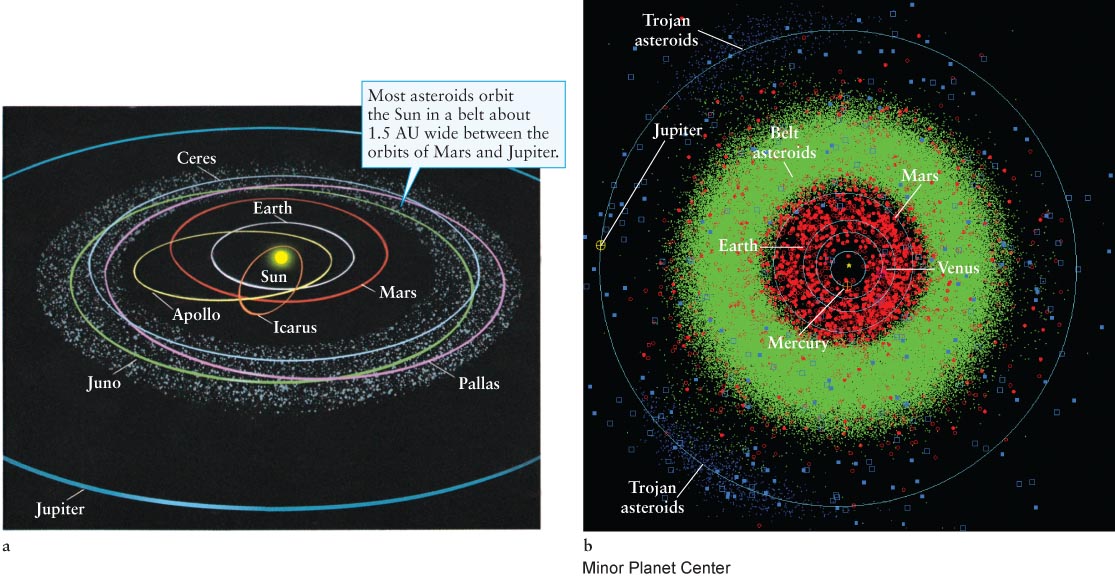
The spacecraft Dawn was sent in 2007 to explore the two most massive belt asteroids Ceres and Vesta, neither of which can be well resolved from Earth. Exquisitely detailed images of Vesta, taken in 2012, reveal that its heavily cratered northern hemisphere is more than a billion years older than the smoother southern hemisphere (Figure 8-
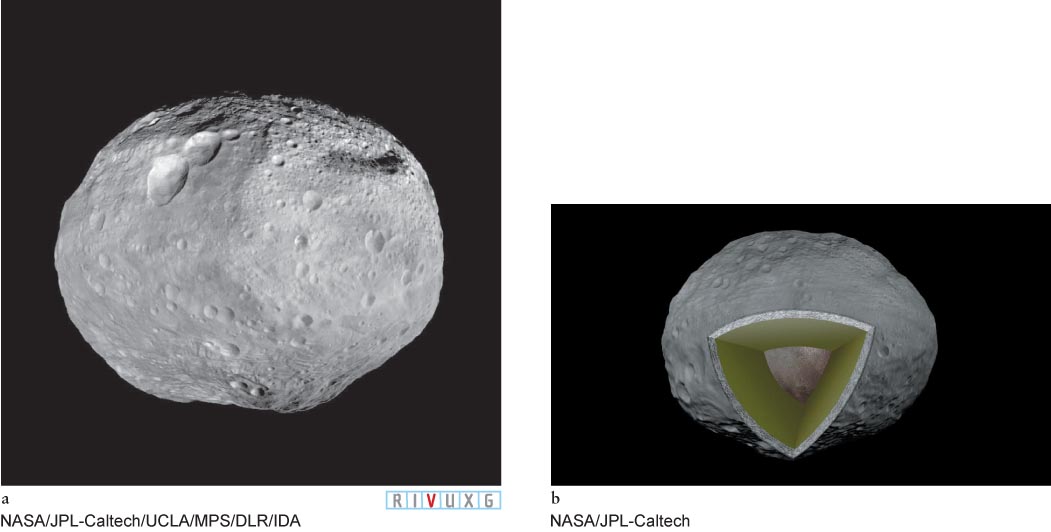
 Asteroid Vesta (a) Imaged in 2012 by the Dawn spacecraft, Vesta’s northern and southern hemispheres have different amounts of cratering. The rough area on the bottom is the mountain at the south pole and its environs. (b) Vesta’s internal structure, with iron at the center, surrounded by a mantle of rock (in green) and a thick crust (in gray).
Asteroid Vesta (a) Imaged in 2012 by the Dawn spacecraft, Vesta’s northern and southern hemispheres have different amounts of cratering. The rough area on the bottom is the mountain at the south pole and its environs. (b) Vesta’s internal structure, with iron at the center, surrounded by a mantle of rock (in green) and a thick crust (in gray).
Asteroids were discovered one by one throughout the nineteenth century. The next real breakthrough came in 1891, when the German astronomer Max Wolf applied photographic techniques to asteroid searching. A total of 300 asteroids had been found up to that time, each painstakingly discovered by scrutinizing the skies for faint, uncharted “stars” whose positions shifted slowly from one night to the next. With the advent of astrophotography, however, the floodgates were opened. Astronomers could simply aim a camera-

 Discovering Asteroids In 1998, the Hubble Space Telescope found this asteroid while observing objects in the constellation Centaurus. The exposure, tracking stars, shows the asteroid as a 19″ streak. This asteroid is about 2 km (1.2 mi) in diameter and was located about 140 million km (87 million mi) from Earth.
Discovering Asteroids In 1998, the Hubble Space Telescope found this asteroid while observing objects in the constellation Centaurus. The exposure, tracking stars, shows the asteroid as a 19″ streak. This asteroid is about 2 km (1.2 mi) in diameter and was located about 140 million km (87 million mi) from Earth.
Records of all objects smaller than planets in our solar system are kept by the Minor Planet Center in Cambridge, Massachusetts. The center reports that as of mid-
240
Insight Into Science
Confirming Observations New findings in science must be confirmed or replicated by other scientists before discoveries or observations are accepted by the scientific community. Therefore, asteroid observations need to be repeated several times to determine exact orbits and eliminate the possibility that a sighting is of a known asteroid or other object.
 The Nice model of how the solar system formed explains that most of the debris in the present area of the asteroid belt was ejected by the passage of young Jupiter through this region going both inward and then out again, as discussed in Section 4-
The Nice model of how the solar system formed explains that most of the debris in the present area of the asteroid belt was ejected by the passage of young Jupiter through this region going both inward and then out again, as discussed in Section 4-
While Jupiter likely disrupted the mass developing in what is now the asteroid belt some 4.5 billion years ago, the fact that it has left this region does not mean that its influence there has ended.
8-4 Jupiter’s gravity creates gaps in the asteroid belt
In 1867, the American astronomer Daniel Kirkwood called attention to gaps in the asteroid belt. These features, called Kirkwood gaps, show the influence of Jupiter’s gravitational attraction there today. Figure 8- ,
,  ,
,  , and
, and  ) of Jupiter’s orbital period. The gravitational pull of Jupiter created these empty regions by giving objects in them periodic reinforcing tugs that pulled the orbiting bodies to different orbits. The effect is analogous to the gravitational resonance of Mimas creating the Cassini division in Saturn’s rings (see Section 7-
) of Jupiter’s orbital period. The gravitational pull of Jupiter created these empty regions by giving objects in them periodic reinforcing tugs that pulled the orbiting bodies to different orbits. The effect is analogous to the gravitational resonance of Mimas creating the Cassini division in Saturn’s rings (see Section 7-
Focus Question 8-3
Why do astronomers doubt that the asteroid belt was once made up of a single planet?
241

 ,
,  ,
,  , and
, and  of Jupiter’s orbital period. Resonant orbits with Jupiter have deflected asteroids away from these orbits. The Trojan asteroids accompany Jupiter as it orbits the Sun.
of Jupiter’s orbital period. Resonant orbits with Jupiter have deflected asteroids away from these orbits. The Trojan asteroids accompany Jupiter as it orbits the Sun.
 It is likely that the asteroid belt contains tens of millions of asteroids, yet the typical separation between “neighboring” asteroids is an impressive 1 million km (600,000 mi). This is quite unlike the image that has been created by innumerable popular movies and television shows of asteroids so close together that you must dodge them as you fly past.
It is likely that the asteroid belt contains tens of millions of asteroids, yet the typical separation between “neighboring” asteroids is an impressive 1 million km (600,000 mi). This is quite unlike the image that has been created by innumerable popular movies and television shows of asteroids so close together that you must dodge them as you fly past.
Despite the large average separation between asteroids, the gravitational influences of Mars and Jupiter have sent some asteroids smashing into each other at various times over the past 4.6 billion years. In 2010, astronomers observed two such events (Figure 8-
242
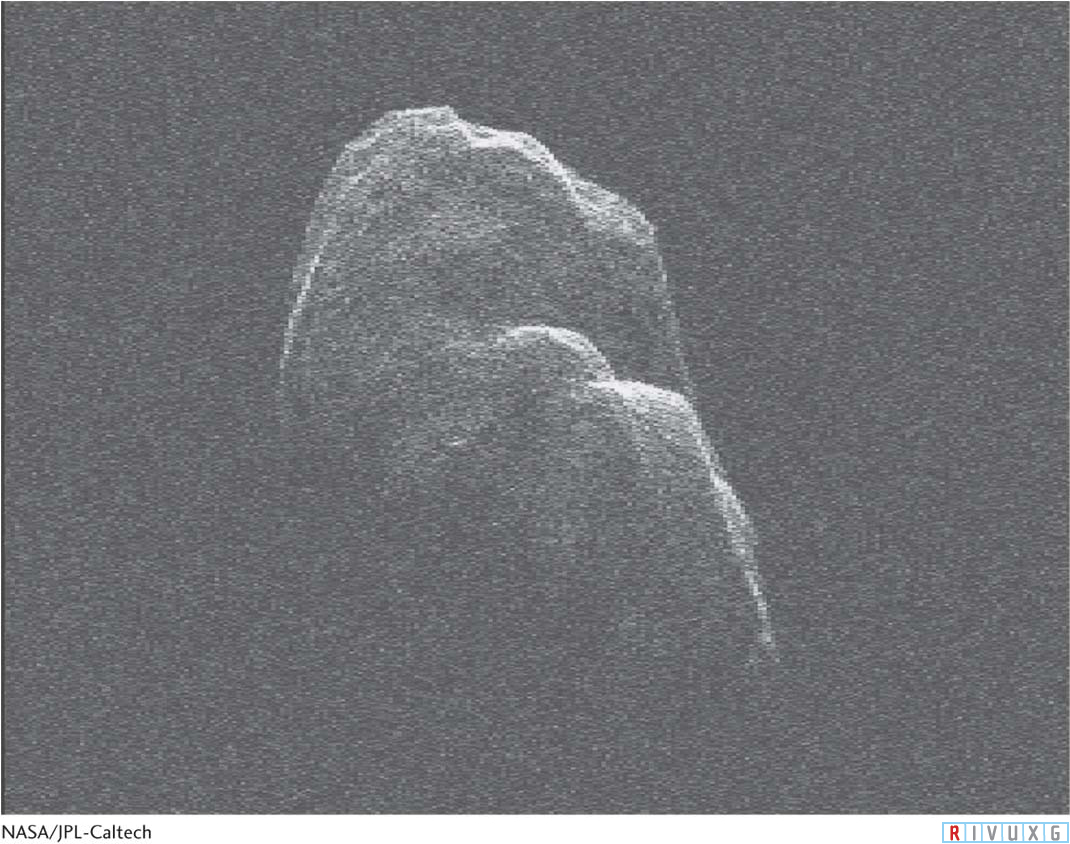
 Asteroid Toutatis An asteroid whose orbit crosses Earth’s, Toutatis was imaged by NASA’s Goldstone Solar System Radar in December 2012.
Asteroid Toutatis An asteroid whose orbit crosses Earth’s, Toutatis was imaged by NASA’s Goldstone Solar System Radar in December 2012.
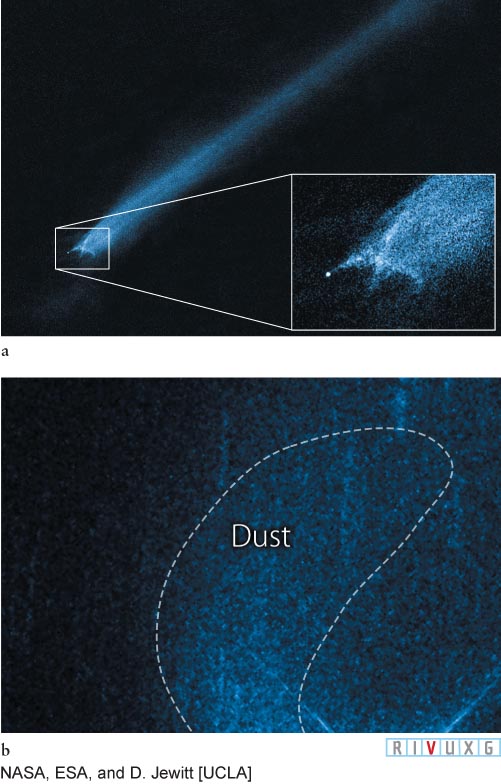
 Collisions Between Two Asteroids (a) Observed in 2010, this X-
Collisions Between Two Asteroids (a) Observed in 2010, this X-Alternatively, several large fragments, such as Ida and Dactyl (Figure 8-
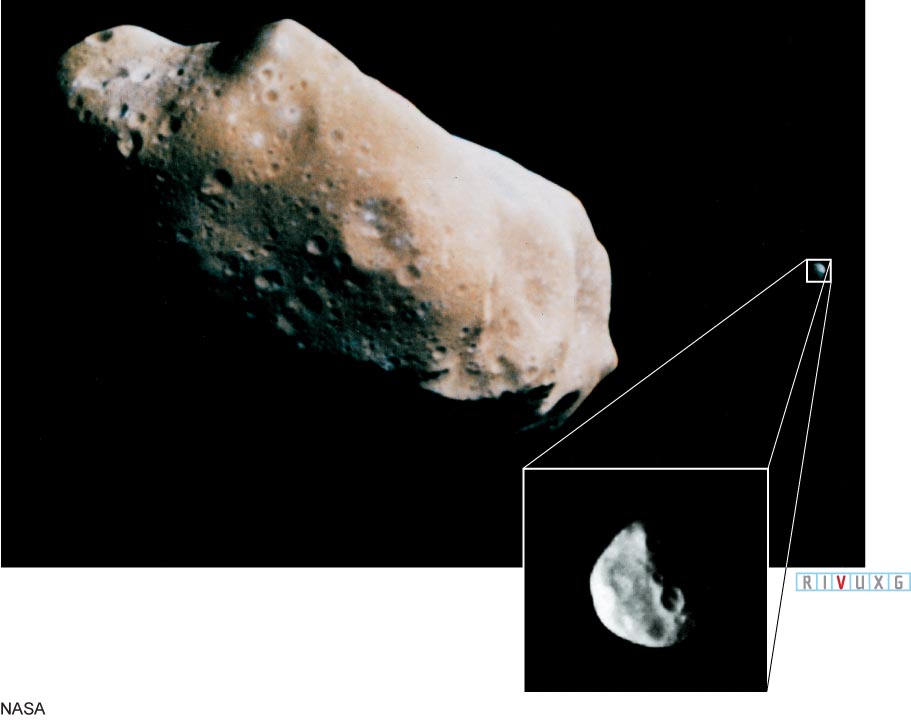
 Ida and Its Satellite The 55-
Ida and Its Satellite The 55-Insight Into Science
Backstories Scientists continually apply the “laws of nature” to new situations, problems, observations, experiments, and even popular culture. For example, applying Newton’s law of gravity to the asteroids reveals that they could never swarm, as science fiction movies suggest. At those close quarters, their gravity would cause them either to collide or to pass so close together that they would subsequently fly rapidly and permanently apart.
Some asteroids are just weakly bound agglomerations of rock and metal. In 2013, telescopes on Earth and the Hubble Space Telescope observed that asteroid P/2013 R3 is breaking into pieces (Figure 8-

 Disintegration of an Asteroid Asteroid P/2013 R3 was observed fragmenting into at least 10 pieces late in 2013 and early 2014. This sequence (a)–(d) shows Hubble images of the event.
Disintegration of an Asteroid Asteroid P/2013 R3 was observed fragmenting into at least 10 pieces late in 2013 and early 2014. This sequence (a)–(d) shows Hubble images of the event.
243
Another asteroid, P/2013 P5, also discovered in 2013, is rotating and radiating six tails composed of dust from the asteroid body. The tails appear periodically from this 0.43 km (1400 ft) diameter body, which has lost between 100 and 1000 tons of dust, a small fraction of its total mass. Whether this dust is a precursor to the asteroid breaking apart remains to be determined.
In 1918, the Japanese astronomer Kiyotsugu Hirayama drew attention to groups of asteroids that share nearly identical orbits. These fragments are pieces of parent asteroids. Pursuing this line of research, astronomers in 2002 discovered that two large asteroids collided only a few million years ago (very recently in solar system history) and created about 20 separate families or clusters of smaller asteroids. Asteroids in each of these families orbit together. The largest remnant cluster of this impact is named Karin, after its largest member, an asteroid some 20 km (12 mi) across.
In the early 1990s, the Jupiter-
244
The Sun is not the only star with an asteroid belt. In 2001, astronomers discovered that the star Zeta Leporis, 70 ly from Earth in the constellation Lepus (the Hare), has a disk of debris that appears to contain asteroids. This star system is less than 0.5 billion years old; astronomers hope it will provide insights into the early evolution of the asteroids and other objects in the disk of gas and dust that surrounded the early Sun.
8-5 Asteroids also orbit outside the asteroid belt
While Jupiter’s gravitational pull clears out certain areas within the asteroid belt, it actually captures asteroids at two locations in the path of its own orbit. The gravitational forces of the Sun and Jupiter work together to hold asteroids in orbit at these locations, called stable Lagrange points, in honor of the French mathematician Joseph Lagrange, whose calculations explained them. One Lagrange point is located 60° ahead of Jupiter, and the other is 60° behind, as shown in Figure 8-
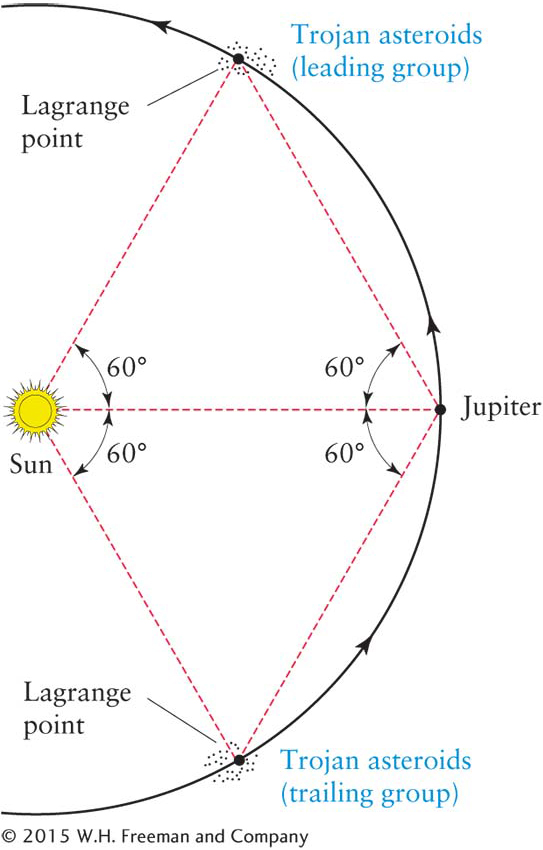
The asteroids trapped at Lagrange points are called Trojan asteroids. Jupiter’s Trojan asteroids are each named after a hero of the Trojan War. As of June 2014, 6073 Trojan asteroids orbiting with Jupiter have been cataloged. Neptune has nine known Trojan asteroids, Mars has five, and Earth and Uranus each have one.
Small solar system bodies orbiting primarily between Jupiter and Neptune are called centaurs. The largest known centaur, Chariklo, is especially interesting because it was observed to have two rings. These were discovered in 2014.
Other asteroids have highly elliptical orbits. Some of these pass through the inner regions of the solar system (see the red dots in Figure 8-
Several close calls took place in recent years. In 1972, space debris was observed to skip off Earth’s atmosphere and retreat back into space. On December 9, 1994, asteroid 1994 XM1 (10 m across—

 Asteroid 2012 DA14 This image, taken on February 15, 2013, 7 hours before its closest approach, shows the asteroid as a streak. The camera tracked stars for 3 minutes in order to obtain the image. At closest approach, 2012 DA14 was moving so fast that the same image would have been made in only 15 seconds.
Asteroid 2012 DA14 This image, taken on February 15, 2013, 7 hours before its closest approach, shows the asteroid as a streak. The camera tracked stars for 3 minutes in order to obtain the image. At closest approach, 2012 DA14 was moving so fast that the same image would have been made in only 15 seconds.
During these close encounters, astronomers can examine the details of asteroids. For example, an asteroid’s brightness often varies as it rotates because different surface features scatter different amounts of light. Such data show that typical rotation periods for asteroids are between 5 and 20 hours, although one asteroid, labeled 2010 JL88, rotates about once every 24.5 seconds! This body is the fastest rotating natural object known in the solar system.
245
The proximity of asteroids and the promise of learning more about these ancient and extremely varied members of our solar system prompted NASA to send the Near Earth Asteroid Rendezvous (NEAR) Shoemaker spacecraft to visit asteroids Mathilde (Figure 8-


 Asteroids (a) Reflecting only half as much light as a charcoal briquette, Mathilde is half as dense as typical stony asteroids. Slightly larger than Ida (see Figure 8-
Asteroids (a) Reflecting only half as much light as a charcoal briquette, Mathilde is half as dense as typical stony asteroids. Slightly larger than Ida (see Figure 8-246
NEAR Shoemaker revealed that Mathilde is only 1.3 times denser than water and has an albedo of 0.04, making it darker than charcoal. This heavily cratered, carbon-
NEAR Shoemaker also showed that Eros (Figure 8-
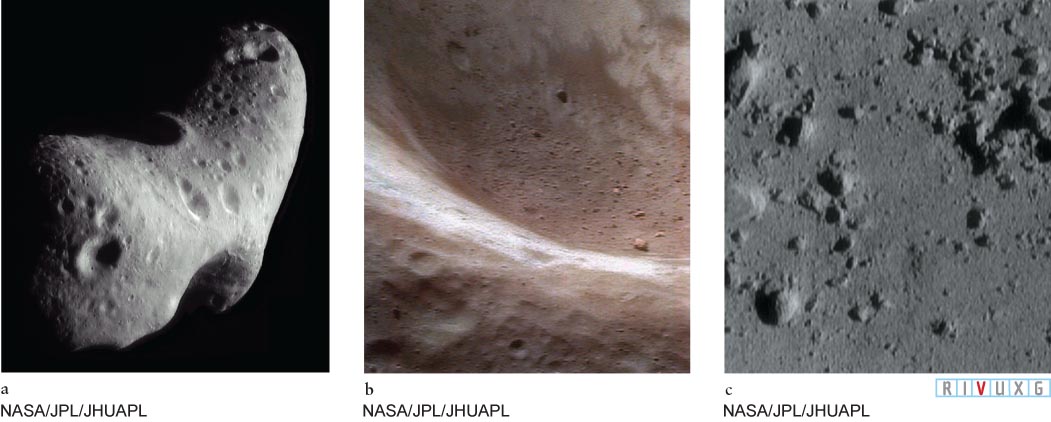
 Asteroid Eros The Near Earth Asteroid Rendezvous (NEAR) Shoemaker spacecraft took these images of asteroid Eros in February 1999. (a) The top of the figure is the asteroid’s north polar region. Eros’s dimensions are 33 km × 13 km × 13 km (21 mi × 8 mi × 8 mi) and it rotates every 5¼ hours. Its density is 2700 kg/m3 (4550 lb/yd3), close to the average density of Earth’s crust and twice as dense as asteroid Mathilde. (b) Looking into the large crater near the top of (a), which is 5.3 km (3.3 mi) across. (c) This is the penultimate image taken by NEAR Shoemaker before it gently landed on Eros. Taken from an altitude of 250 m (820 ft), the image is only 12 m (13 yd) across. You can see rocks and boulders buried to different depths in the regolith.
Asteroid Eros The Near Earth Asteroid Rendezvous (NEAR) Shoemaker spacecraft took these images of asteroid Eros in February 1999. (a) The top of the figure is the asteroid’s north polar region. Eros’s dimensions are 33 km × 13 km × 13 km (21 mi × 8 mi × 8 mi) and it rotates every 5¼ hours. Its density is 2700 kg/m3 (4550 lb/yd3), close to the average density of Earth’s crust and twice as dense as asteroid Mathilde. (b) Looking into the large crater near the top of (a), which is 5.3 km (3.3 mi) across. (c) This is the penultimate image taken by NEAR Shoemaker before it gently landed on Eros. Taken from an altitude of 250 m (820 ft), the image is only 12 m (13 yd) across. You can see rocks and boulders buried to different depths in the regolith.